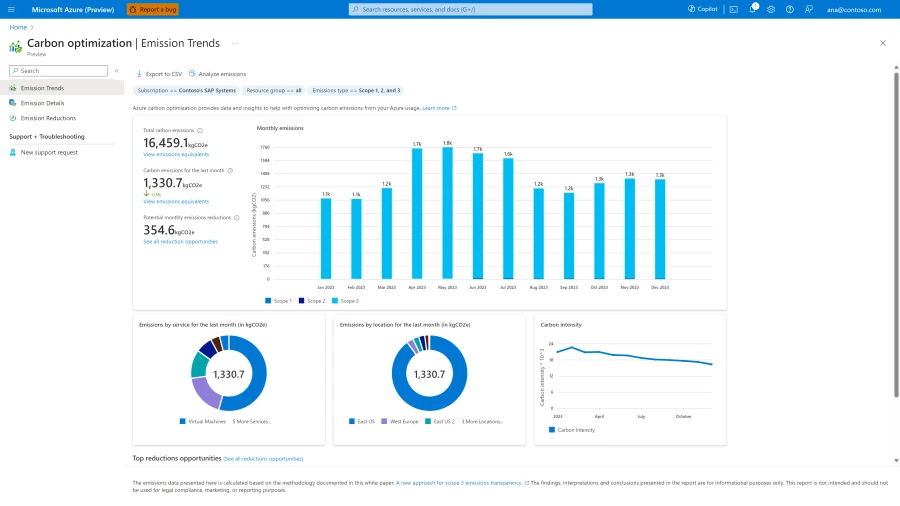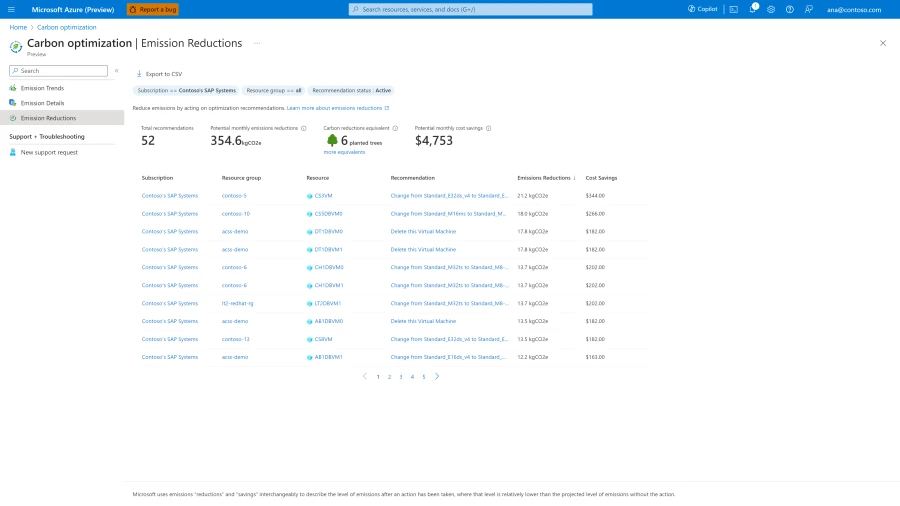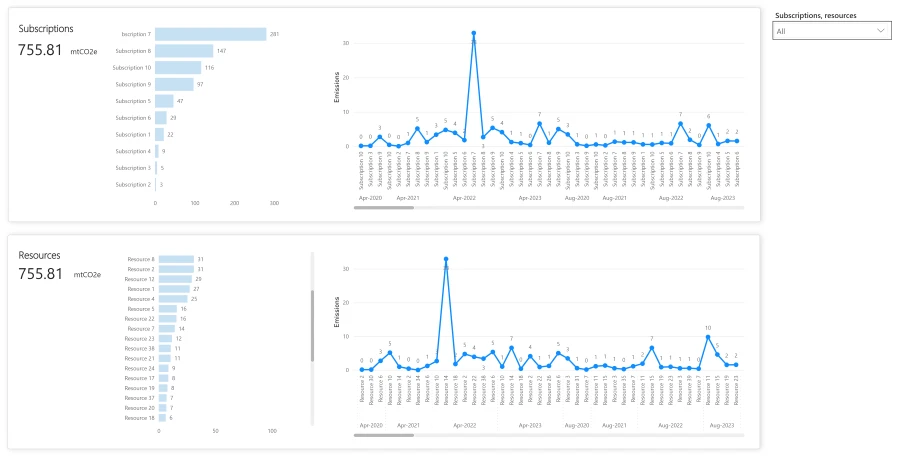
Achieving sustainable growth with Azure and FinOps best practices

To understand the impact of cloud computing on carbon emissions, precise measurement, trustworthy data, and robust tools are essential… That’s why we’re excited to announce two new capabilities to optimize your Microsoft Azure emissions: Azure Carbon Optimization (preview) is a f…
Companies worldwide are committed to reducing their IT carbon footprint, championing a more sustainable future through initiatives focused on efficiency and cost optimization. Cloud sustainability is not only about reducing the environmental impact of cloud usage, but also about making smart business decisions that align to corporate values, adhere to regulatory requirements, and enable the pursuit of long-term business goals. To understand the impact of cloud computing on carbon emissions, precise measurement, trustworthy data, and robust tools are essential.
That’s why we’re excited to announce two new capabilities to optimize your Microsoft Azure emissions:
- Azure Carbon Optimization (preview) is a free, cutting-edge capability that empowers Azure developers and IT professionals to understand and optimize emissions stemming from Azure usage. By providing insights into carbon emissions and offering recommendations for enhancing cloud efficiency, this tool aligns with the Microsoft commitment to environmental responsibility and supports you in achieving your cloud sustainability goals.
- Microsoft Azure emissions insights (preview) in sustainability data solutions in Microsoft Fabric enables you to unify and analyze emissions data for Azure usage. By having access to your Azure emissions data in Microsoft Fabric, you can query and drill down into Azure resource level emissions for advanced reporting and analysis.
Both tools offer a holistic solution for organizations aiming to reduce their carbon footprint by optimizing specific resources or workloads within Azure.
With Azure Carbon Optimization (preview), engineering and IT teams can use ready-to-consume insights and recommendations for optimizing their carbon emissions, all within the Azure portal. Microsoft Azure emissions insights (preview) enable data analysts and engineers to dive deeper into emissions data, allowing them to slice and dice the data and perform deeper analytics using Microsoft Fabric.
Once your organization can access insights into the carbon emissions generated at the resource or workload level, reduction efforts can begin. This involves optimizing cloud systems for efficiency to benefit the environment and enhance overall performance. Azure administrators can already see a company-wide view of cloud emissions in the Emissions Impact Dashboard. To optimize your carbon footprint, you can take advantage of more granular insights into carbon emissions originating from specific resources or workloads.
Like any major organizational shift, reducing carbon emissions requires contributions from every corner of your company. In this blog, we will not only explore the benefits of Azure Carbon Optimization and Microsoft Azure emissions insights, but also how the FinOps framework can guide your business through the complexities of carbon emission reduction to help achieve both your environmental and financial goals.
Align IT sustainability with ESG regulations
Organizations around the world are setting carbon neutrality goals for themselves, which are furthered by new environmental regulations and standards introduced by global government and regulatory bodies, with a significant driver being environmental, social, and governance (ESG) regulations. These governmental standards dictate ESG-related actions, reporting, and disclosures.
Microsoft provides offerings to help customers with their ESG reporting needs with tools and products available with Microsoft Cloud for Sustainability to help your organization collect and manage more ESG data and get fuller visibility into your environmental impact. Our goal is to help prepare you for any new reporting requirements by compiling a comprehensive ESG data estate.
IT sustainability plays a pivotal role in a company’s ESG management strategy because it serves as a cornerstone for mitigating environmental impact, ensuring responsible cloud usage, and reinforcing the overall commitment to sustainable development practices. There are also direct economic benefits for reducing carbon emissions, such as long-term operational cost savings.
Above all, organizations that proactively address environmental issues and reduce their carbon footprint will be better positioned for long-term success, especially in a business landscape where sustainability is increasingly important.
Measure and reduce your emissions with Azure Carbon Optimization
Our free Azure Carbon Optimization tool, now in public preview and accessible through your Azure portal, is a window into your cloud resources emissions, ultimately leading to recommendations on how to cut back. It empowers Azure users to closely monitor and optimize their carbon footprint.

Azure Carbon Optimization is designed to provide everyone in your organization, from developers, to architects, to IT professionals, with a resource-level view of emissions data. This empowers your engineers to take proactive measures to mitigate emissions and track progress right from the Azure portal.
Azure Carbon Optimization uses the same carbon accounting methodology as the Emissions Impact Dashboard. Developers can work towards maximizing resource utilization while minimizing carbon emissions from the cloud, helping ensure that every deployed resource serves a purpose, eliminates waste, and reduces environmental impact. The tool also presents carbon emission reduction in equivalent terms that are easy for anyone to understand.
Subsequently, it provides developers with carbon savings recommendations that are based on analyzing resource utilization. Suggestions include deleting or resizing underutilized resources. With these ready-to-consume recommendations, you can optimize your Azure usage, avoid carbon emissions, and promote sustainable development practices. This way, you not only enhance your environmental performance, but also achieve cost savings and efficiency.

Perform even deeper Azure emissions analysis with Microsoft Fabric
Microsoft Azure emissions insights, now in public preview, is a part of the sustainability data solutions in Microsoft Fabric. It helps unify, process, query, and perform deeper analysis of Azure emissions data. In addition to emissions data and related pipelines, Power BI dashboards are provided with Microsoft Azure emissions insights to drill-down and compare emissions data across subscriptions and resources. This helps IT administrators identify patterns in Azure emissions that evolve with time and change with Azure resource usage.

Unified Azure emissions data empowers data analysts to enrich the emissions data with custom information such as department using subscriptions and resources. They can then query the data and build analytic models for interesting insights such as Azure emissions by departments and seasonality of emissions by usage.
Leverage FinOps best practices to help optimize carbon emissions
Fostering a culture of accountability, efficiency, and governance across an organization stands as a key objective within the FinOps framework, which aims to help organizations optimize their cloud to maximize business value.
Efficiency has a positive impact on innovation by freeing up resources and allowing organizations to invest more in modernization, research, and development. FinOps supports the customer journey by establishing a cross-functional team that includes finance, IT, engineers, and business leaders to create a culture of accountability where everyone takes ownership of their cloud usage.
As ESG regulations compel adherence to complex emissions reporting requirements, integrating FinOps best practices can help teams to better manage and optimize carbon emissions. When viewed through the lens of environmental awareness, FinOps can assist with best practices that foster accountability, efficiency, and governance to enable data-driven decisions.
Leveraging these best practices in tandem with Azure Carbon Optimization and Microsoft Azure emissions insights empowers your organization to be a catalyst for change, transforming cloud practices into a force for sustainability by helping track, analyze, and optimize emissions towards a greener, more responsible cloud ecosystem.
Reach your sustainability goals with data-driven Azure insights
By employing these capabilities and adhering to FinOps practices, your organization can actively track, assess, and mitigate your carbon emissions. You’ll not only gain a detailed understanding of the emissions impact associated with your Azure resources, but also valuable insight into your compliance posture for any coming ESG regulations.
Next steps
Visit the Azure Carbon Optimization documentation and our new learning collection to discover more about how to start leveraging the data-driven insights provided by Azure Carbon Optimization for a more environmentally responsible and efficient operation.
Continue your sustainability journey with the Azure Well-Architected Framework sustainability guidance and explore Sustainability outcomes and benefits for business through the Cloud Adoption Framework. This guidance provides insights into end-to-end sustainability considerations in your cloud estate.
Visit the documentation for Microsoft Azure emissions insights and this new blog to learn more about deploying it in your Fabric environment and get started with centralizing and analyzing your Azure emissions data. This capability can be leveraged to analyze the trends of your Azure emissions over time by subscriptions and resources.
For more on how FinOps best practices can help you maximize your cloud business value while addressing the complexities of carbon emission reduction, explore Microsoft’s resources for FinOps:
- Assess your organization’s gaps using the Microsoft FinOps Review Assessment.
- Gain hands-on experience with Microsoft solutions that empower FinOps through the Microsoft FinOps Interactive Guides.
- Explore a range of related Microsoft products and services on the FinOps on Azure homepage.

Visit the Azure Carbon Optimization documentation
Start leveraging data-driven insights and reduce your emissions today
The post Achieving sustainable growth with Azure and FinOps best practices appeared first on Microsoft Azure Blog.
Author: agiamalis
